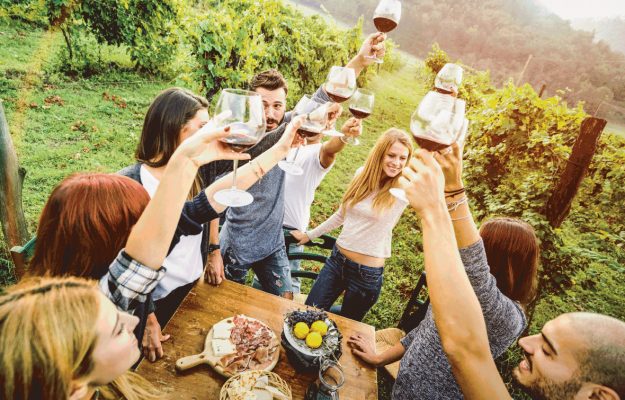The Italian wine market of high quality is always linked to catering and consequently, to tourism and wine tourism. Which recovery in 2021, showed encouraging signs. But today, almost out of the pandemic, with so many restrictions about to fall in part from April 1, and then almost completely from May 1, the war, international tensions and rising costs, everything is back in question. Said that, for wine, “main trends” such as sustainability, the link with the territory and the enhancement of native vines, remain strengths on which to work to build the new tomorrow. Messages coming from Verona from institutions, companies and academics in the Assoenologi Congress.
If in 2021 exports exceeded 7 billion euros, recalled Denis Pantini of Nomisma Wine Monitor (led by Prosecco with 1.3 billion euros, together with reds from Tuscany and Piedmont, whites and reds from Veneto, whites from Trentino Alto Adige and Friuli Venezia Giulia, reds and whites from Sicily and whites from Tuscany among the categories more performing in terms of value), sales in large-scale distribution have grown again and the Horeca has restarted in part, the consequences of the war between Russia and Ukraine, including those directed on two markets which for Italian wine, as a whole, represent more than 400 million euros, and above all the indirect ones, which amplify the growth in energy and raw material costs already in the end of 2021 and are also leading to supply problems for bottles, paper and so on, they will weigh heavily. Nevertheless, in the construction of the “wine of the future”, according to research by Nomisma, which has sounded the opinions of producers, bio and sustainability will weigh above all (89%) and low alcohol content (45%). Values that matter for the most advanced consumers, while for 85% of consumers, who are “non-experts”, underlined Vincenzo Russo, Professor of Consumer Psychology and Neuromarketing at the IULM free University of Languages and Communication in Milan, we must take into account above all the emotional aspect, the first impact, “Because those who choose emotionally stay on the shelf for 5 to 24 seconds, and it is the label that sells the first bottle”.
But, as mentioned, if the catering has restarted in a great way, “also thanks to young people who are increasingly interested in quality wine, with the great classics such as Brunello di Montalcino, Barolo and so on that are always good, and a great growth of southern wines”, said Alessandro Rossi, National Category manager Wine Partesa, it is the international context that is worrying, starting from the transversal theme of energy costs. “That can only be solved by working at the European level, by setting a common ceiling on the price of gas and without looking at individual national interests, but at those of the European Union as a whole”, said the Minister of Agriculture, Stefano Patuanelli, stimulated by the journalist and producer Bruno Vespa, underlining how the issue of energy independence, for Italy, means investing more in renewable sources, because “with those fossils we have we can go little further”.
The worry, however, is also on the wine tourism front, in a year in which, among other things, the Minister of Tourism, Massimo Garavaglia, reiterated, in a video message, the World Congress on the subject organized by the Tourism Agency of Onu will be on stage for the first time, in Italy, in September, in Alba, “recognition of the value of the Belpaese, which, in tourism linked to wine and gastronomy, has a fundamental asset”, said the Minister.
The impact of the war on tourism has already been felt – said Donatella Cinelli Colombini, producer in Montalcino, and pioneer of the Wine Tourism Movement – reservations for Easter have stopped, expensive fuel will weigh on Italian tourism, and is still a long way to go for the return of the Americans, who are the real big spenders in our cellars. But we must continue to invest in training and projects related to hospitality and animation in the cellar, and there are many opportunities. Let’s look, for example, at South Africa, where there are crocodile and ostrich farms. But also Angora rabbit farms. And remember that an elephant is big as a male Chianino ox. So, if we can organize animation around every agricultural sector, we give a boost to all Italian tourism and remember that Italy’s main attraction for foreigners is not its artistic heritage, but it is wine and food”. However, ad hoc professional training and simplification are needed: “the law on wine tourism is in force in 2019, but only half of the Regions have implemented it”, said the first signatory of the law, the senator Dario Stefàno. “Today there are 30,000 wineries in Italy open to the public, but of the 8-10,000 are well organized for wine tourism”, added Cinelli Colombini. Numbers that say a lot about how many there are still, the unexpressed potential of an important sector for an Italy that, today more than ever, cannot waste any opportunity to catch the restart”.
To give some confidence, however, there is the fact that historically, Italian wine has faced and overcome many crises, becoming even stronger. “And he will make it this time
Copyright © 2000/2025
Contatti: info@winenews.it
Seguici anche su Twitter: @WineNewsIt
Seguici anche su Facebook: @winenewsit
Questo articolo è tratto dall'archivio di WineNews - Tutti i diritti riservati - Copyright © 2000/2025








































































































































































































